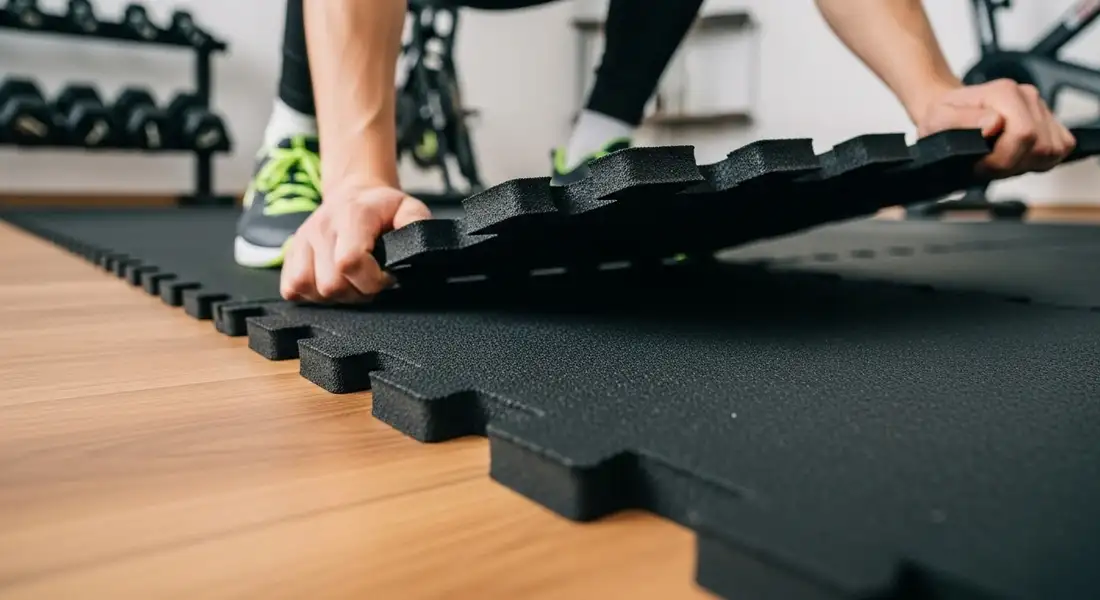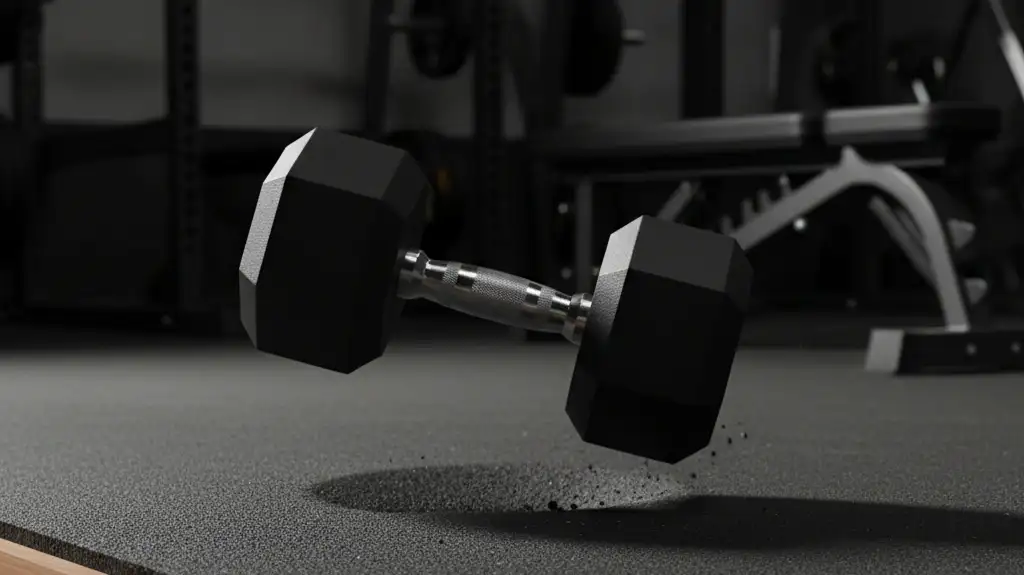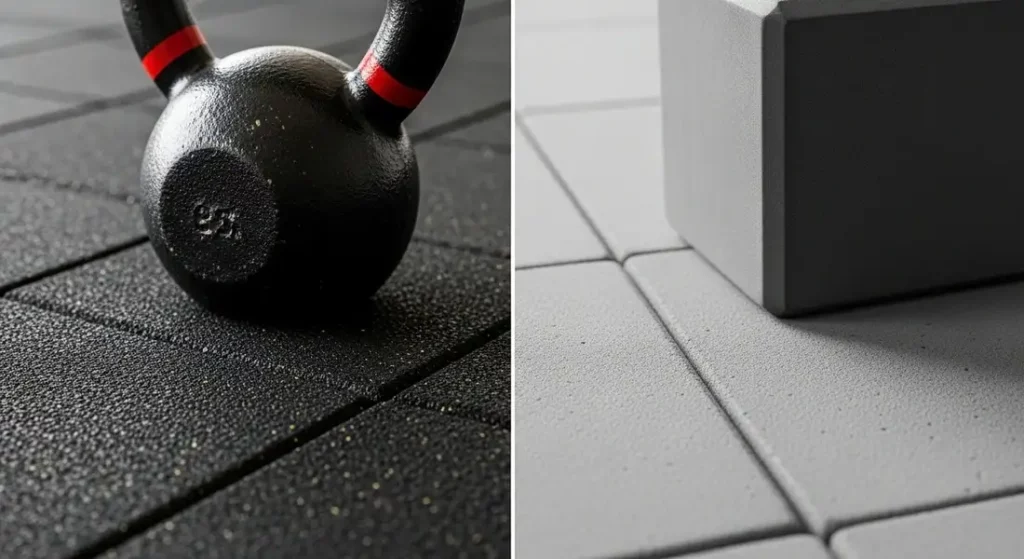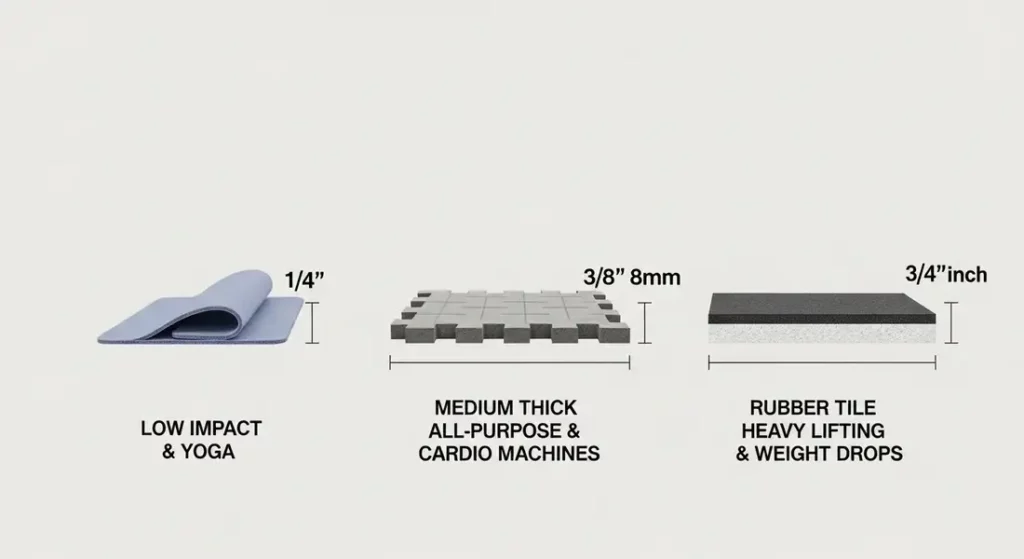When planning a home gym, it’s exciting to think about the shiny new dumbbells or the high-tech treadmill.
But what’s underneath your feet is one of the most critical investments you’ll make.

The right flooring is the unsung hero of a great home gym—it protects your house, your body, and your equipment.
Skipping this step can lead to cracked tiles, dented hardwood, and a noisy, unsafe workout environment.
In this essential part of our Ultimate Beginner’s Guide to Setting Up a Home Gym, we’ll break down the best flooring options so you can build your fitness space on a solid foundation.
Why You Absolutely Can’t Skip Home Gym Flooring

Think of your gym floor as a crucial piece of safety equipment.
Its job is to do much more than just cover the ground.
- Ultimate Floor Protection: This is the most obvious benefit. Dropping a 20-pound dumbbell on unprotected hardwood or tile can cause irreversible damage. The right flooring absorbs that impact, saving you from costly repairs.
- Personal Safety & Joint Health: Exercising on a hard, unforgiving surface like concrete can be brutal on your joints. Good gym flooring provides essential shock absorption, cushioning your knees, ankles, and back during high-impact activities. It also provides a vital slip-resistant surface.
- Equipment Longevity: A stable, level floor prevents your expensive machines from rocking or shifting, which can cause wear and tear over time. It also protects your free weights from getting scratched or damaged.
- Noise Reduction: If you live with others or in an apartment, flooring is your best friend. It significantly dampens the noise from dropped weights, jumping, or the rhythm of a treadmill, keeping the peace in your household.
The Top Home Gym Flooring Materials Explained

Choosing the right material depends on your workout style, the type of equipment you have, and your budget.
Let’s break down the most popular choices.
Rubber Flooring (The Gold Standard)
When you picture a commercial gym floor, you’re thinking of rubber.
It’s the top choice for a reason, offering the best all-around performance and durability.
- Pros: Superior durability and shock absorption, excellent for protecting floors from heavy weights, highly slip-resistant, and easy to clean.
- Cons: Can be the most expensive option, heavy and difficult to move, and may have a distinct rubber smell for the first few weeks.
- Best For: Serious weightlifting, HIIT workouts, placing under heavy cardio machines—basically, any all-purpose home gym.
- Deep Dive: For a complete overview, explore our Rubber Gym Flooring – The Ultimate Guide.
EVA Foam Tiles (The Budget-Friendly Choice)
These lightweight, interlocking tiles are what many beginners start with.
They are affordable, easy to install, and provide excellent cushioning.
- Pros: Very affordable, incredibly lightweight, simple to assemble and disassemble, and offers great comfort for floor exercises.
- Cons: Not durable enough for heavy weights (will permanently dent), can be less stable under heavy machines, and can be slippery when wet.
- Best For: Bodyweight workouts, yoga, Pilates, martial arts, and designated stretching areas. They are a fantastic, affordable home gym flooring solution for low-impact activities.
- Learn More: See if this is the right fit in our guide to EVA Foam Floor Tiles for Your Home Gym.
Carpet Tiles (For Comfort & Low Impact)
While you wouldn’t want to deadlift on plush carpet, high-quality, low-pile carpet tiles can be a surprisingly good option for certain types of home gyms.
- Pros: Comfortable and warm underfoot, provides good cushioning for bodyweight exercises, and has natural sound-dampening qualities.
- Cons: Can absorb sweat, dust, and odors, making it difficult to clean thoroughly. Not suitable for heavy, shifting equipment or messy workouts.
- Best For: Yoga and meditation spaces, low-impact cardio, and multi-purpose rooms where comfort is a priority.
Vinyl Flooring (The Multi-Purpose Chameleon)
If your gym needs to double as a playroom or home office, vinyl (specifically Luxury Vinyl Tile/Plank) is a stylish and highly durable option.
- Pros: Extremely durable and resistant to scuffs, scratches, and water. Very easy to clean and comes in countless styles, including realistic wood and stone looks.
- Cons: Hard surface with very little shock absorption (often requires a rubber mat on top for workouts), and can be slippery.
- Best For: Multi-purpose rooms, cardio machine areas, and home gyms where aesthetics and ease of cleaning are top priorities.
Quick Comparison – Which Flooring is Right for You?
Use this table to make a quick decision based on your primary needs.
| Flooring Type | Durability | Shock Absorption | Cost | Best For… |
| Rubber | ★★★★★ | ★★★★★ | | Weightlifting, HIIT, All-Purpose Gyms |
| EVA Foam | ★★☆☆☆ | ★★★★☆ | $ | Bodyweight, Yoga, Low-Impact Cardio |
| Carpet Tiles | ★★★☆☆ | ★★★☆☆ | Stretching, Low-Impact, Multi-Use | |
| Vinyl | ★★★★★ | ★☆☆☆☆ | Cardio Machines, Multi-Use Rooms |
Key Features to Look For When Buying

Once you’ve chosen a material, consider these specifics:
- Thickness: This is crucial. For general use and light weights, 8mm (about 1/3 inch) is a good starting point. For serious weightlifting and dropping heavy weights, look for flooring that is 1/2 inch thick or more.
- Installation Style: Interlocking tiles are incredibly DIY-friendly and allow you to customize the size and shape of your gym area. Rolled flooring offers a more seamless, professional look but can be heavy and difficult to install alone. Our guide on Easy Home Gym Flooring Installation can help you decide.
- Cleaning and Maintenance: Look for non-porous materials like rubber or vinyl that won’t absorb sweat and are easy to wipe down. A clean gym is a motivating gym. Learn the best practices in our How to Clean Your Home Gym Floor guide.
Build Your Gym on a Solid Foundation
Choosing the right flooring is a foundational step you won’t regret.
It’s an investment in your safety, the longevity of your home, and the overall quality of your workouts.
By matching your flooring material to your fitness routine, you create a space that is not only functional but also safe and inviting for years to come.
With your floor protected, it’s time to think about what you’ll put on it and how to plan your spending wisely.
Next Step: Learn How to Budget for Your First Home Gym Setup
